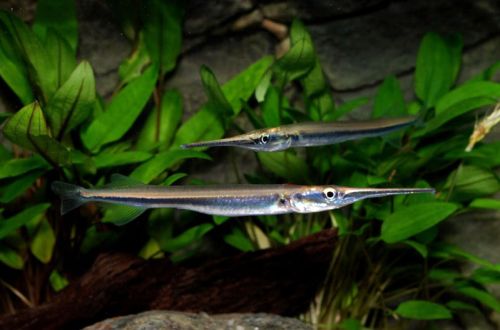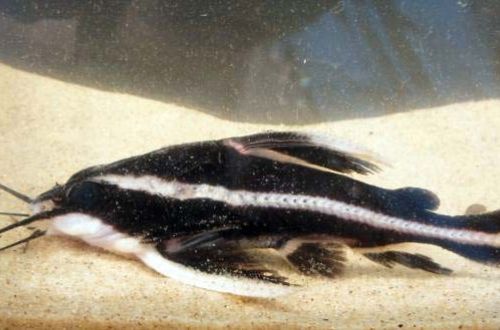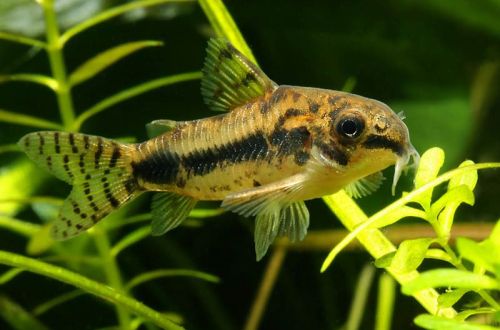
needlefish
Freshwater Garfish, Freshwater Needlefish or Silver Needle Fish, scientific name Xenentodon cancila, belongs to the Belonidae family. Under the same name, its closest relative Xenentodon canciloides is supplied, which is practically indistinguishable from the outside. These species can be described as peaceful predators. The fish have an unusual appearance, are easy to keep and are compatible with many other species. A similar set of qualities determined their popularity in the aquarium hobby. However, nutritional features do not allow recommending to amateurs.

Contents
Habitat
Comes from Southeast Asia. The habitat extends from Pakistan and India further east – Nepal, Bangladesh, Sri Lanka, Myanmar and Thailand. Wild populations were brought to the islands of Hawaii, where they successfully took root.
They inhabit low-speed rivers and streams, swamps. During the rainy season, as the water level rises, they swim into faster rivers, artificial and irrigation canals. They prefer poorly lit places with dense coastal vegetation.
Brief information:
- The volume of the aquarium – from 500 liters.
- Temperature – 22-28°C
- Value pH — 6.0–8.0
- Water hardness – soft to medium hard (2-15 dGH)
- Substrate type – any
- Lighting – subdued
- Brackish water – no
- Water Movement – Low/Moderate
- The size of the fish is up to 35 cm.
- Nutrition – live and fresh food
- Temperament – peaceful
- Keeping in a group of 3-4 individuals
Description
Adult individuals reach a length of up to 35 cm. A characteristic feature of the species is the structure of the body – very thin and very elongated. Thanks to this shape, the fish got one of its names “Silver Needle”. Sexual dimorphism is weakly expressed. Nevertheless, the male is quite easy to distinguish from the female. In males, the dorsal and anal fins have a black border. In addition, during the mating season, a small hump grows behind the head, the lower jaw acquires a reddish tint, and the abdomen becomes yellow-gold.
Food
Predator, in nature feeds on small fish and insects. In a home aquarium, adults should be fed fish strips, shrimp, mussels, large earthworms, flies, crickets, and other insects. Young specimens can be content with small earthworms, pieces of shrimp.
Maintenance and care, arrangement of the aquarium
The optimal size of the tank for 3-4 fish starts from 500 liters, the depth should be at least 30 cm. The design should provide for dense clusters of plants placed along the walls of the aquarium, thus preserving free areas for swimming. The lighting is subdued. The presence of plants floating on the surface and hanging over the water is welcome. Since they serve as an additional means of shading, in this case it will be necessary to increase the brightness of the light. Other decorative elements and soil are selected at the discretion of the aquarist.
A productive filtration system is a must when keeping predatory species. In addition to the power of the filter, you should pay attention to what and how the purified water returns. Depending on the models and types of filters, water is returned in various ways, some of which create excessive flow. In the case of the Freshwater pipefish, the internal current should be kept to a minimum.
The high quality of water is also maintained by its weekly change (by 20-30% of the volume) and regular removal of organic waste from the surface of the substrate and decorative elements.
Behavior and Compatibility
Predatory, but not aggressive. The garfish is able to get along with other calm fish that are large enough to fit in his mouth. It is worth avoiding the settlement of overly active and restless species, such as Barbs. There are no intraspecific conflicts. It prefers to stay in a small flock of three to four individuals.
Breeding / breeding
Breeding needlefish in a home aquarium is difficult due to the need to recreate the changes in habitat conditions that occur in nature. The mating season occurs from May to September, when a large amount of precipitation falls in Southeast Asia, changing the hydrochemical composition of the water and lowering its temperature. The female lays several eggs daily, fixing them to the flooded vegetation with thin sticky threads. The incubation period lasts from 7 to 10 days. The hatched fry feed on zooplankton. As they mature, larger fish may eat their smaller counterparts.
Fish diseases
In favorable conditions, the likelihood of disease is minimal. The main causes of diseases are the deterioration of water quality and poor quality feed. For example, feeding on live fish can lead to parasite infestation. For more information on symptoms and treatments, see the Aquarium Fish Diseases section.





